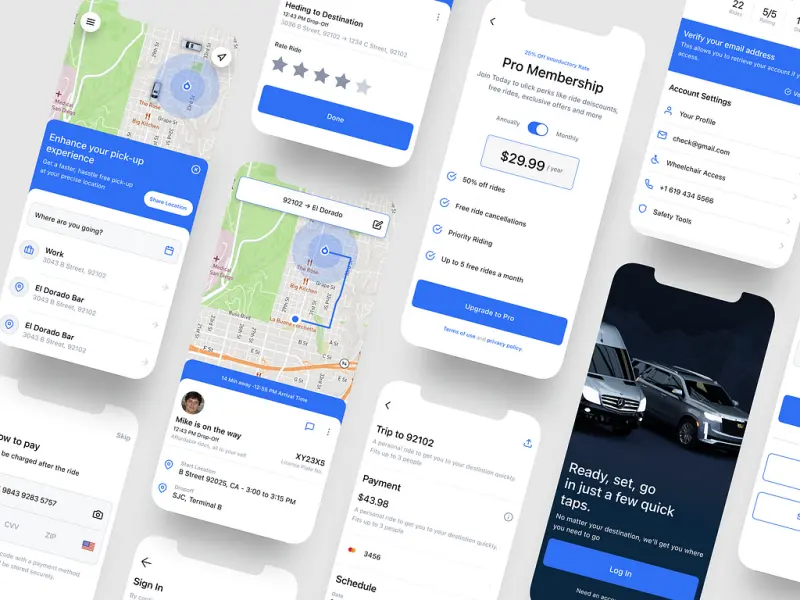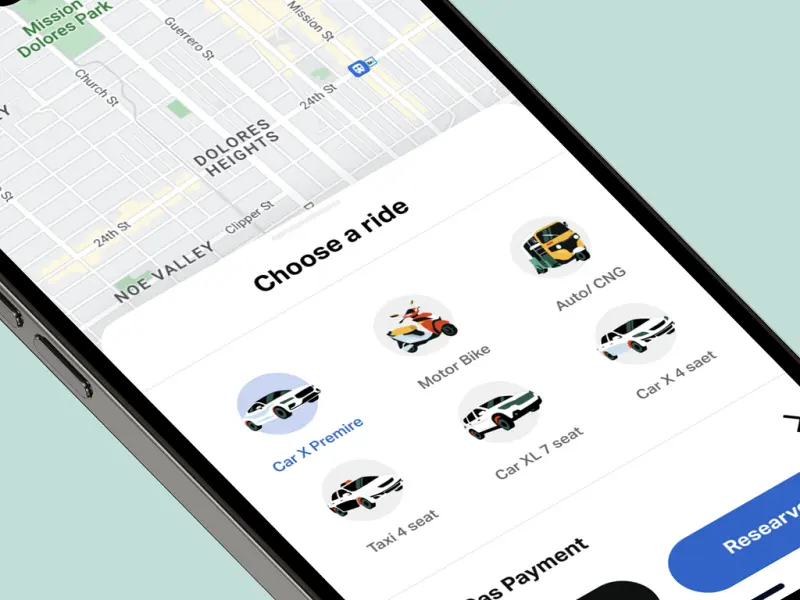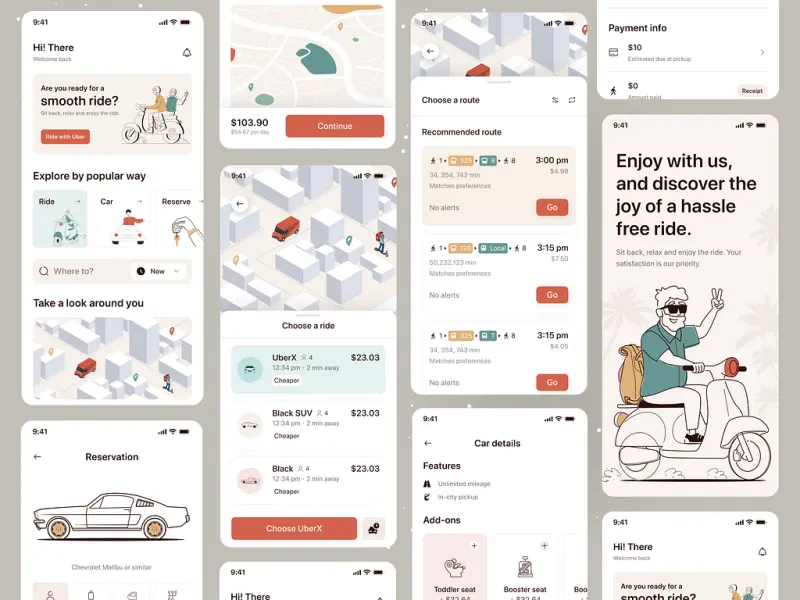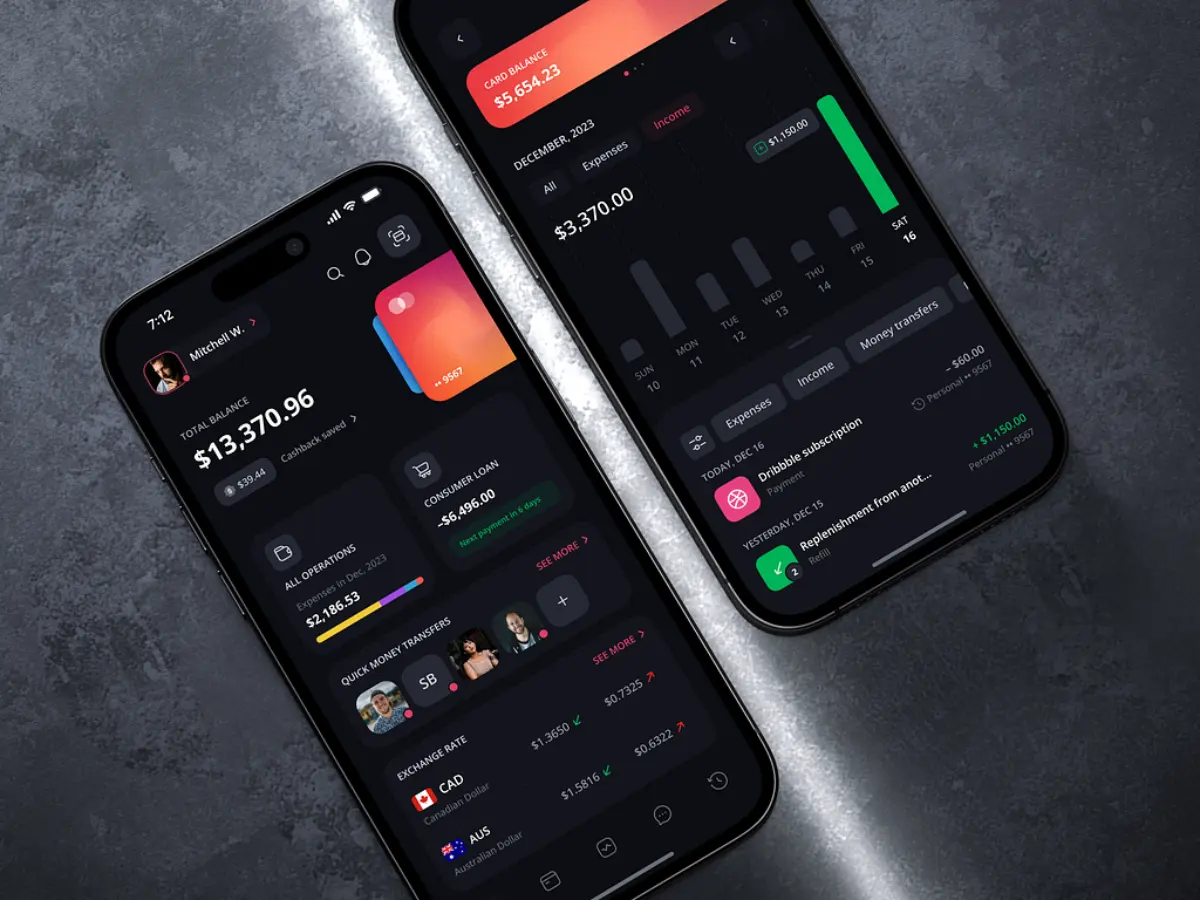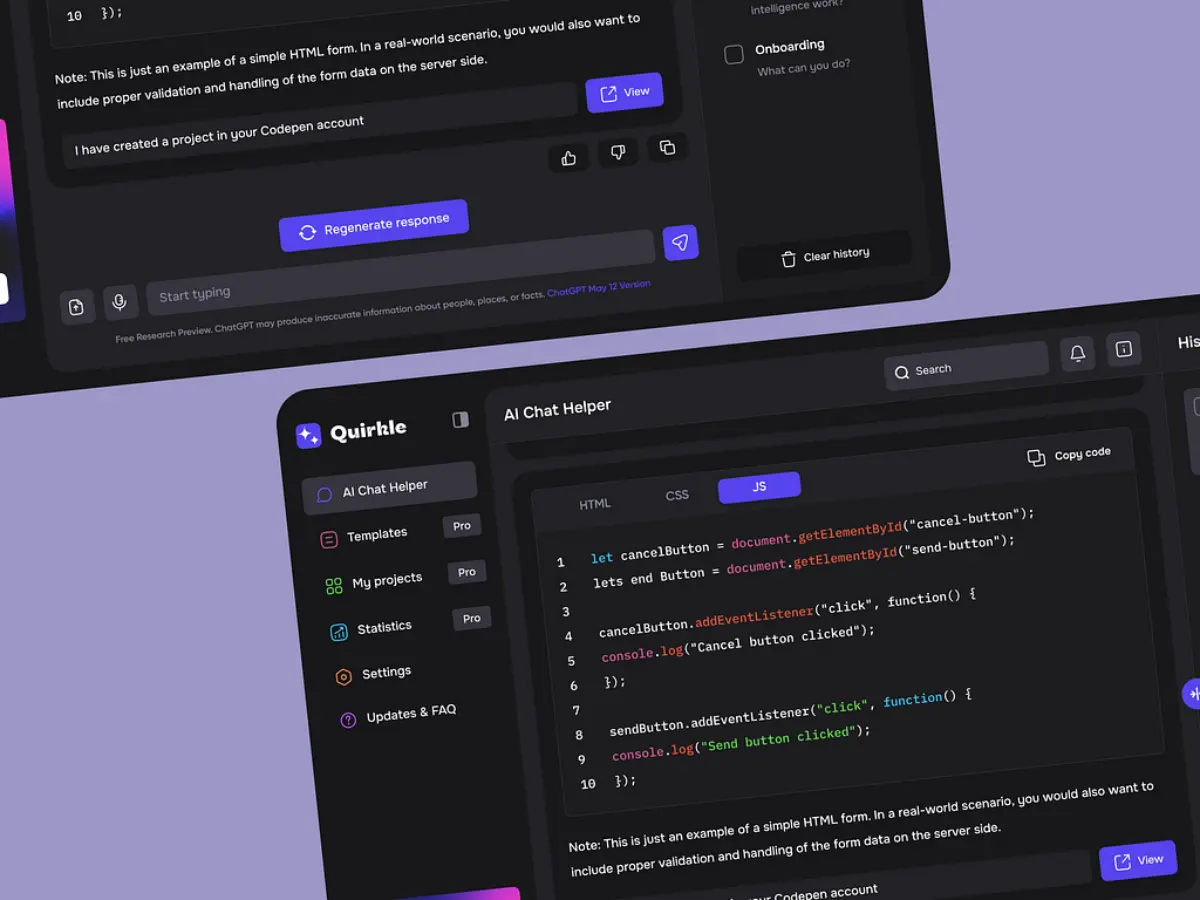How to Create a Rideshare App from Scratch: Complete Guide to Success
- TECHVIFY Team
- 0 Comments
Chances are, you’ve got a few ride-hailing apps on your phone right now, showing just how popular these services have become. More and more companies are jumping into the on-demand market, hoping to shake up industries dominated by big names. We’ve seen this happen before with Airbnb’s impact on hotels or Uber’s disruption of the traditional taxi industry.
If you’re looking to tap into this opportunity and want to learn how to create a rideshare app, we’ve put together a complete guide, crafted with insights from our expert developers who’ve built rideshare apps for the U.S. market. Let’s dive in.
I. The Rapid Growth of Ride-Hailing Apps
The global ridesharing industry is growing at an incredible pace. In the U.S., major players like Uber, Lyft, and DiDi are generating billions in revenue. Across Europe, BlaBlaCar, one of the most popular platforms, now operates in over 400 cities and serves around 1.5 million users.
And the market isn’t slowing down. The ridesharing industry is projected to grow by over 50% between 2020 and 2021, reaching an estimated value of $117 billion by the end of 2021.
Ride sharing app
As this market continues to expand, so does the number of rideshare apps. Studies show that about 70% of all trips taken by car passengers are now through ridesharing services.
The idea of ridesharing is clearly a hit with consumers. But before you jump into the industry, getting a good understanding of the market is important. So, let’s take a look at the top players and their market valuations.
- Lyft earned around $2.3 billion in revenue in 2020, according to Statista and Wikipedia.
- Uber generated approximately $11.1 billion in revenue in the same year, as reported by Statista.
- According to a MarketsAndMarkets report, the global ridesharing market is projected to grow at a compound annual growth rate (CAGR) of 16.6%, with market value projected to hit $185.1 billion by 2026.
From these numbers, it’s clear that ridesharing apps are growing at an outstanding rate. This presents an exciting opportunity for entrepreneurs interested in building their own ridesharing app. Now, let’s walk through the steps to make that happen.
Stay up-to-date with our most recent articles about transportation:
II. Top Ride-Sharing Solutions on the Market
If you’re thinking about developing a ride-sharing app, it’s always helpful to look at some of the most successful projects out there. Let’s explore some of the top players in the ride-sharing space and see what makes them stand out.
Uber
One of the most well-known names in the ride-sharing world is Uber, and their uberPOOL feature is a great example of how to share rides. UberPOOL gives users a more affordable option compared to traditional taxi services, thanks to its competitive pricing. With a large network of drivers, riders can usually find a trip at the standard fare without much hassle.
Compared to taxis, UberPOOL helps keep costs lower, especially for groups traveling together. The platform also makes it easy to split payments among passengers, making it a convenient option for larger groups. While Uber is a major player, there are several other ride-sharing apps worth noting as well.
Lyft
Lyft is another big competitor in the ride-sharing industry, serving over 600 cities across the U.S., including major hubs like New York, Los Angeles, and San Francisco. Lyft has also expanded into 12 Canadian cities as part of its push to grow internationally. The app provides multiple vehicle options for users to choose, from standard mid-sized cars to larger Lyft Plus vehicles, and even includes scooter rentals.
Lyft also has its own carpooling service called Lyft Line, which allows passengers to share rides and split the fare, similar to UberPOOL.
BlaBlaCar
BlaBlaCar is the world’s largest international ride-share platform, boasting over 35 million users. Founded in 2006 in Paris, the service now operates in 22 countries and continues to expand. By January 2016, BlaBlaCar was valued at $1.6 billion.
This platform connects drivers (usually private car owners) with passengers looking to travel to the same destination. Drivers offer available seats in their cars, and passengers can book those seats through the app. BlaBlaCar also allows users to plan trips in advance, and after the ride, both drivers and passengers can leave feedback for each other, helping to build trust within the community.
Gett
Gett, originally known as GetTaxi, offers ride-sharing in more than 100 cities worldwide, including the U.K. and Israel. However, the company recently ceased operations in the U.S. to focus on the corporate transportation market. Despite this, U.S. users can still book rides through a partnership with Lyft, allowing them to access Lyft’s network of drivers via the Gett app.
Gett’s pricing model is one of its standout features, as it eliminates surge pricing during peak hours, providing more predictable fares for passengers.
Via
The startup Via is another innovative player in the ride-sharing market. Via aims to redefine urban transportation by using technology to share rides more efficiently. Their app matches multiple passengers heading in the same direction and combines them into one vehicle, usually a larger SUV or van.
Via operates using a system of virtual bus stops, where passengers are picked up based on traffic conditions and demand. This setup helps reduce costs and makes urban travel more efficient.
Curb
Curb offers a ride-sharing experience similar to Uber and Lyft, but with a few unique twists. One of the standout features of Curb is the ability to pre-schedule a ride in certain cities for a small fee, allowing users to book in advance and have a driver waiting at a specific time and place.
Another great feature is Pair and Pay, available in cities like New York, Boston, Philadelphia, Miami, and Las Vegas. This allows users to pay for their ride through the app by entering a code from the taxi they’ve chosen, making the payment process more seamless.
III. How to Build a Ride-Sharing App in 7 Steps
Creating a ride-sharing app involves a clear process to ensure success. Below is a detailed guide to help you through each stage of development, from initial research to final deployment.
How to create a rideshare app
Step 1: Conduct Market Research
Start by thoroughly analyzing the existing ride-sharing apps in the market. Make a list of the top apps and study their features, ratings, and reviews. User feedback can highlight gaps or problems in current apps, giving you insight on how to improve your product.
Understanding your target audience is crucial. For example, GoKid is designed for families, schools, and teammates—this specific audience influences the app’s features and design. Similarly, determine who your app will serve and what their unique needs are. Conduct surveys, analyze market trends, and monitor competitors’ social media to gain a deeper understanding of your audience and the competition.
Step 2: Choose a Mobile Platform
Decide whether to build a native app (specific to iOS or Android) or a hybrid app (works on both platforms). Native apps generally deliver superior performance and a more seamless user experience, while hybrid apps can be more cost-effective and quicker to deploy.
Your decision should be based on where your target market is located. For example, Android dominates in Europe, while iOS has a stronger foothold in North America. Conducting surveys in your target region will help you make an informed choice.
Step 3: Pick the Right Technology Stack
The technology stack you choose will depend on various factors, including your team’s expertise and the specific features you need to implement. For example, real-time tracking may require certain backend technologies. If you’re unsure, consult with an external development agency that specializes in ride-sharing apps.
The key is to select a stack that aligns with your app’s requirements and your team’s capabilities, ensuring the app is scalable and efficient in the long term.
Step 4: Hire a Ride-Sharing App Development Company
Hiring an experienced app development company can simplify the process. An agency with experience in ride-sharing apps will be familiar with the common challenges and can help you bring your idea to life more efficiently.
Such companies provide all the necessary resources, including developers, designers, and testers, under one roof. They can also provide helpful recommendations for enhancing your app based on industry best practices.
Step 5: Create Wireframes and UI/UX Design
Wireframing is a crucial step in visualizing the app’s layout and user flow. Here’s why it’s important:
- Foundation: Wireframes help you understand whether the layout and navigation meet your expectations before moving to full-scale design.
- Save Time: Identifying and fixing issues in the wireframe stage will save you time and money during development.
- Visual Understanding: Wireframes provide a blueprint of how the app’s screens will look and how users will interact with different features.
Once the wireframe is ready, you can move on to designing the UI/UX:
- UI Design: Focus on creating a visually appealing interface that aligns with your brand.
- UX Design: Ensure the user experience is smooth and intuitive. The app should be easy to navigate, with a consistent design across all screens.
A well-designed UI/UX can significantly improve user retention and set you apart from competitors.
Step 6: Develop an MVP (Minimum Viable Product)
If you’re working with a limited budget or want to test the market early, start by developing a Minimum Viable Product (MVP). An MVP focuses on the core features necessary to solve your users’ core problems. This method enables a quick launch while collecting valuable user feedback, which you can use to improve the app over time.
The MVP will help you validate your idea with minimal risk and investment, and you can continue incorporating additional features based on user feedback and market demands.
Step 7: Testing and Deployment
Before launching your app, it’s essential to go through comprehensive testing to ensure everything functions as intended. Here’s how the process works:
- Quality Assurance (QA): Your QA team will test the app for bugs, performance issues, and usability problems.
- Beta Testing: Consider releasing a beta version of the app to a small group of users to get feedback and identify any remaining issues.
- Fix Bugs: Based on the QA and beta testing feedback, your developers will fix any bugs and optimize the app for performance.
Once testing is complete, it’s time to deploy your app to the app stores:
- Google Play Store: Android apps are typically reviewed and approved within a few hours.
- Apple App Store: iOS apps can take up to 48 hours for review.
After the app is live, be prepared to maintain it by fixing bugs, adding new features, and keeping the user experience fresh and engaging.
Have a Project Idea in Mind?
Get in touch with experts for a free consultation. We’ll help you decide on next steps, explain how the development process is organized, and provide you with a free project estimate.
IV. Key Features for Developing a Ride-Sharing App
When it comes to building a ride-sharing app, you have two main options:
- Develop separate apps for drivers and passengers (for iOS and/or Android).
- Create an all-in-one app that caters to both drivers and passengers.
Build a rideshare app
Registration & Profile
For passengers:
The user journey begins with registration, and it’s best to keep this process simple. Prompt passengers to sign up using their phone number or allow them to sign up via social media platforms. Once registered, users can upload a profile picture, add their name, phone number, and payment details, and view their payment history and driver ratings.
To offer a personalized experience, consider allowing passengers to set preferences like requesting a nonsmoking driver, opting for no music, or choosing female drivers.
For drivers:
Drivers must go through a more detailed registration process, including submitting personal information and verifying their tax number. They also need to provide contact details, upload photos, and any other necessary documents required by the ride-sharing company.
Drivers should be able to set their work schedule and switch to “online” mode when they’re ready to accept rides. Additionally, they should have access to a profile that allows them to track their trips, earnings, tips, and reviews.
Notifications & Communication
For passengers:
Passengers don’t want to be left in the dark while waiting for a ride. Push notifications are essential, keeping users informed about ride status, potential delays, cancellations, or any payment issues.
Communication is also key. While passengers and drivers often call each other to clarify details, it’s a good idea to implement an in-app chat system. This allows passengers to leave specific instructions or interact with the driver directly through the app.
For drivers:
Similarly, drivers should receive notifications about ride requests, cancellations, or any changes in ride details. Notifications ensure that drivers stay updated without needing to constantly monitor the app.
Booking
For passengers:
Here’s how a streamlined booking process should work:
- Step 1: Passengers need to input their payment details if they haven’t already added them to their profile.
- Step 2: They enter their current location and destination.
- Step 3: Passengers choose the type of car, driver rating, and preferred fare. These options can help differentiate your app from competitors.
The ride price is usually calculated based on the pickup and drop-off locations. Heat maps, like those used by Lyft, can be a great tool to see where demand is highest and adjust pricing accordingly.
For drivers:
Drivers should be given the choice to accept or reject a ride request. To keep things moving, there should be a time limit for drivers to respond. For instance, in apps we’ve developed, drivers have 10 seconds to accept a ride before it’s passed on to another driver.
My Rides
For passengers:
Frequent users will want easy access to their ride history. A dedicated My Rides tab can list completed trips along with details like:
- Price
- Driver information
- Destination
- Payment details
For drivers:
The same feature should be available for drivers, allowing them to view past rides, earnings, and other relevant details.
GPS Location
GPS is essential for both passengers and drivers. It not only saves time by eliminating the need to manually input locations but also makes real-time tracking possible.
Passengers can track their driver’s location, and if the GPS sends the driver off course, the passenger can call and provide directions. This feature is key to minimizing delays and improving the user experience.
Payments
Payments should be processed before the ride is completed, ensuring that drivers get paid even if a passenger cancels at the last minute. If cash payments are accepted, make sure it’s clear to passengers before they book a ride.
Most ride-sharing apps use third-party payment processors like Braintree, Stripe, or PayPal to securely handle transactions. Don’t forget to include a tipping feature, allowing passengers to tip drivers after the ride, especially for cashless payments.
Reviews & Ratings
Ratings and reviews should work both ways—drivers and passengers should be able to rate each other. This helps maintain a high standard of service and ensures that problematic users or drivers can be flagged or banned if necessary.
Passenger feedback helps improve driver behavior and driving skills. For instance, no one wants to ride with a driver who’s rude or overly talkative, so these ratings can help others make informed decisions.
Localization
If your app operates internationally, offering a multilingual interface is a must. Even if your app is only available in one country, it’s wise to include additional languages to accommodate foreign users.
Make sure to focus on the location of your operations, offering English and other official languages spoken in the region.
Admin Panel
An admin panel is essential for managing the app’s backend. We recommend building the admin panel as a web app so that staff can easily manage operations from a computer. Admins should have full access to:
- Passenger and driver profiles
- Payment transactions
- Ride statistics
- Reports and feedback
Unique Value Proposition (UVP)
Finally, setting your app apart from competitors is crucial. Whether it’s through a unique booking process, specific vehicle types, or personalized ride preferences, your app’s Unique Value Proposition (UVP) will help attract and retain users. Think creatively about what makes your app stand out in a crowded market.
V. Future of Ride-Sharing Apps in the Sharing Economy
The total global revenue from the sharing economy is projected to reach $40.2 billion in 2022, with ride-sharing apps playing a significant role in this growth.
Ride-Sharing Apps Growth Forecast
The global ride-sharing market is predicted to grow by over 50% between 2020 and 2021. By 2021, the market value is expected to rise to approximately $117 billion, reflecting the increasing demand for shared mobility solutions.
However, despite the overall growth in the ride-sharing market, Uber’s market value is expected to decline slightly. There are two primary reasons for this:
-
Increased Competition: Uber is no longer the only dominant player in the global iOS and Android app markets. Competitors like Lyft, DiDi, and Grab have gained significant market share.
-
Employment Practices: Uber has faced legal challenges and criticism over its classification of drivers as independent contractors rather than employees. This classification has helped Uber reduce costs but has also been a source of controversy.
Despite these challenges, driver satisfaction remains relatively high. In 2019, over 52% of Lyft drivers and nearly 45% of Uber drivers reported being satisfied with their experience working for these companies.
The Move Toward Self-Driving Cars
The future of ride-sharing is increasingly tied to the development of self-driving vehicles. Uber, in particular, has been investing heavily in autonomous vehicle technology since 2015. The company has tested numerous self-driving cars and poured millions of dollars into the project. At times, Uber’s expenses for its self-driving unit have reached $200 million in a single quarter.
The integration of self-driving cars into ride-sharing fleets could revolutionize the industry by reducing the need for human drivers, significantly cutting operational costs, and enhancing convenience and safety. As the technology matures, the ride-sharing market will likely see a shift toward more autonomous, efficient, and sustainable transportation solutions.
Conclusion
The future of ride-sharing apps is both promising and dynamic. As the market keeps growing and changing, companies will need to navigate a competitive landscape, address regulatory challenges, and embrace cutting-edge technologies like self-driving cars. The opportunity is massive for entrepreneurs and businesses looking to break into this space, but success will depend on a strategic approach to development, innovation, and user experience.
If you’re considering developing a ride-sharing app or want to explore the possibilities within the sharing economy, TECHVIFY is here to help. Our team of skilled developers has vast experience in creating solutions tailored to the U.S. market and beyond.
Contact TECHVIFY today for a free consultation and learn how we can help you bring your ride-sharing app idea to life with precision and expertise.
TECHVIFY – Global AI & Software Solution Company
From Startups to Industry Leaders: TECHVIFY prioritizes results, not just deliverables. Accelerate your time to market and see ROI early with high-performing teams, AI (including GenAI) Software Solutions, and ODC (Offshore Development Center) services.
- Email: [email protected]
- Phone: (+84)24.77762.666




